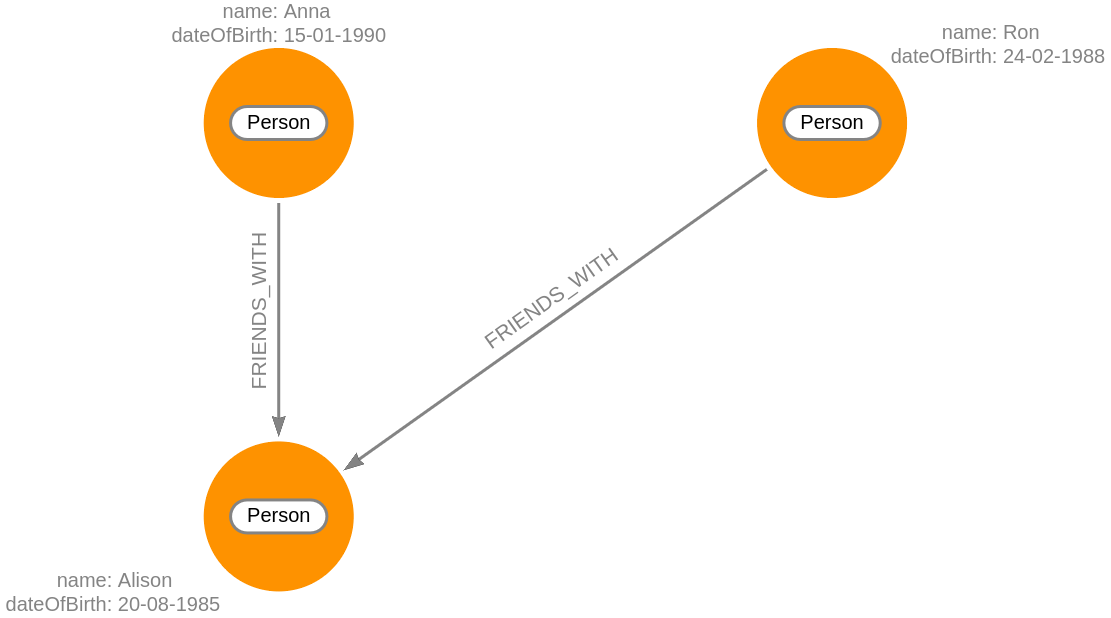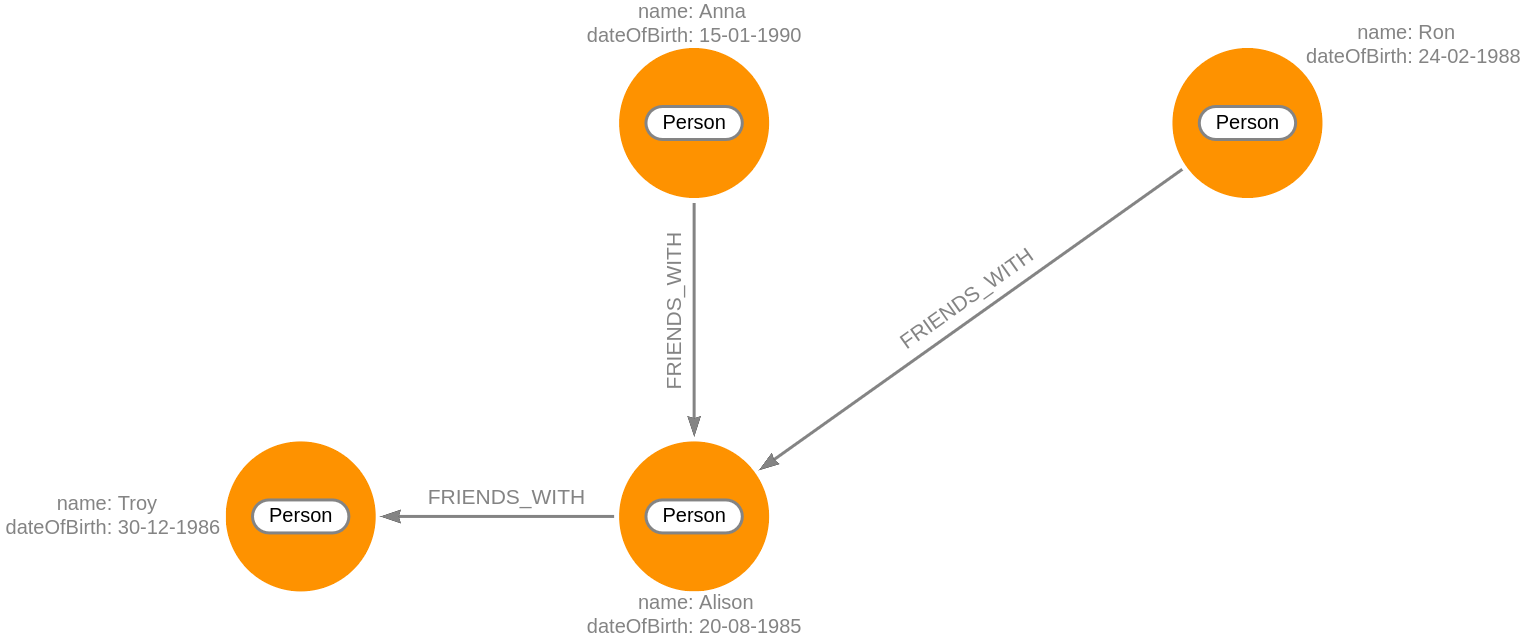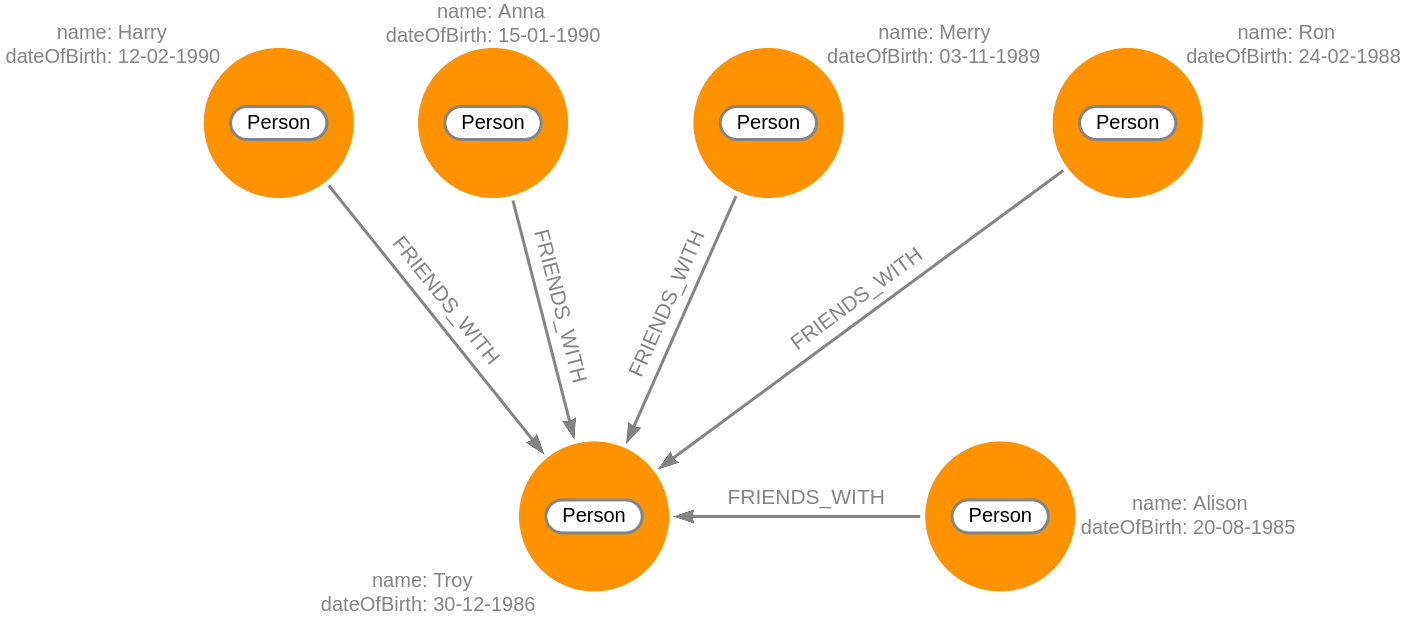Reading existing data
The simplest usage of the language is to find data stored in the database. For that, you can use one of the following clauses:
MATCHwhich searches for patterns.WHEREfor filtering the matched data.RETURNfor defining what will be presented to the user in the result set.UNIONandUNION ALLfor combining results from multiple queries.UNWINDfor unwinding a list of values as individual rows.
MATCH
This clause is used to obtain data from Memgraph by matching it to a given pattern. For example, you can use the following query to find each node in the database:
MATCH (node) RETURN node;
Finding connected nodes can be achieved by using the query:
MATCH (node1)-[connection]-(node2) RETURN node1, connection, node2;
In addition to general pattern matching, you can narrow the search down by
specifying node labels and properties. Similarly, relationship types and properties can
also be specified. For example, finding each node labeled as Person and with
property age being 42, is done with the following query:
MATCH (n:Person {age: 42}) RETURN n;
Each node and relationship gets a identifier generated during their initialization which is persisted through the durability mechanism.
Return it with the [`id()` function](/cypher-manual/functions#scalar-functions).
You can use the following query to find their friends:
MATCH (n:Person {age: 42})-[:FRIENDS_WITH]-(friend) RETURN friend;
There are cases when a user needs to find data that is connected by traversing a
path of connections, but the user doesn't know how many connections need to be
traversed. Cypher allows for designating patterns with variable path
lengths. Matching such a path is achieved by using the * (asterisk) symbol
inside the relationship element of a pattern. For example, traversing from node1 to
node2 by following any number of connections in a single direction can be
achieved with:
MATCH (node1)-[r*]->(node2) RETURN node1, r, node2;
If paths are very long, finding them could take a long time. To prevent that, a user can provide the minimum and maximum length of the path. For example, paths of length between two and four nodes can be obtained with a query like:
MATCH (node1)-[r*2..4]->(node2) RETURN node1, r, node2;
It is possible to name patterns in the query and return the resulting paths. This is especially useful when matching variable length paths:
MATCH path = ()-[r*2..4]->() RETURN path;
More details on how MATCH works can be found here.
The MATCH clause can be modified by prepending the OPTIONAL keyword.
OPTIONAL MATCH clause behaves the same as a regular MATCH, but when it fails
to find the pattern, missing parts of the pattern will be filled with null
values. Examples can be found here.
WHERE
You have already seen how to achieve simple filtering by using labels and
properties in MATCH patterns. When more complex filtering is desired, you can
use WHERE paired with MATCH or OPTIONAL MATCH. For example, finding each
person older than 20 is done with this query:
MATCH (n:Person) WHERE n.age > 20 RETURN n;
Additional examples can be found here.
Regular expressions
Inside WHERE clause, you can use regular expressions for text filtering. To
use a regular expression, you need to use the =~ operator.
For example, finding all Person nodes which have a name ending with son:
MATCH (n:Person) WHERE n.name =~ ".*son$" RETURN n;
The regular expression syntax is based on the modified ECMAScript regular expression grammar. The ECMAScript grammar can be found here, while the modifications are described in this document.
RETURN
The RETURN clause defines which data should be included in the resulting set.
Basic usage was already shown in the examples for MATCH and WHERE clauses.
Another feature of RETURN is renaming the results using the AS keyword.
For example:
MATCH (n:Person) RETURN n AS people;
That query would display all nodes under the header named people instead of
n.
When you want to get everything that was matched, you can use the *
(asterisk) symbol.
This query:
MATCH (node1)-[connection]-(node2) RETURN *;
is equivalent to:
MATCH (node1)-[connection]-(node2) RETURN node1, connection, node2;
RETURN can be followed by the DISTINCT operator, which will remove duplicate
results. For example, getting unique names of people can be achieved with:
MATCH (n:Person) RETURN DISTINCT n.name;
Besides choosing what will be the result and how it will be named, the RETURN
clause can also be used to:
- limit results with
LIMITsub-clause; - skip results with
SKIPsub-clause; - order results with
ORDER BYsub-clause and - perform aggregations (such as
count).
More details on RETURN can be found here.
SKIP & LIMIT
These sub-clauses take a number of how many results to skip or limit. For example, to get the first three results you can use this query:
MATCH (n:Person) RETURN n LIMIT 3;
If you want to get all the results after the first 3, you can use the following:
MATCH (n:Person) RETURN n SKIP 3;
The SKIP and LIMIT can be combined. So for example, to get the 2nd result,
you can do:
MATCH (n:Person) RETURN n SKIP 1 LIMIT 1;
ORDER BY
Since the patterns which are matched can come in any order, it is very useful to
be able to enforce some ordering among the results. In such cases, you can use
the ORDER BY sub-clause.
For example, the following query will get all :Person nodes and order them by
their names:
MATCH (n:Person) RETURN n ORDER BY n.name;
By default, ordering will be ascending. To change the order to be descending,
you should append DESC.
For example, you can use this query to order people by their name descending:
MATCH (n:Person) RETURN n ORDER BY n.name DESC;
You can also order by multiple variables. The results will be sorted by the first variable listed. If the values are equal, the results are sorted by the second variable, and so on.
For example, ordering by first name descending and last name ascending:
MATCH (n:Person) RETURN n ORDER BY n.name DESC, n.lastName;
Note that ORDER BY sees only the variable names as carried over by RETURN.
This means that the following will result in an error.
MATCH (old:Person) RETURN old AS new ORDER BY old.name;
Instead, the new variable must be used:
MATCH (old:Person) RETURN old AS new ORDER BY new.name;
The ORDER BY sub-clause may come in handy with SKIP and/or LIMIT
sub-clauses. For example, to get the oldest person you can use the following:
MATCH (n:Person) RETURN n ORDER BY n.age DESC LIMIT 1;
You can also order result before returning them. The following query will order all the nodes according to name, and then return them in a list.
MATCH (n)
WITH n ORDER BY n.name DESC
RETURN collect(n.name) AS names;
Aggregating
Cypher has functions for aggregating data. Memgraph currently supports the following aggregating functions.
avg, for calculating the average value.sum, for calculating the sum of numeric values.collect, for collecting multiple values into a single list or map. If given a single expression values are collected into a list. If given two expressions, values are collected into a map where the first expression denotes map keys (must be string values) and the second expression denotes map values.count, for counting the resulting values.max, for returning the maximum value.min, for returning the minimum value.
Example, calculating the average age:
MATCH (n:Person) RETURN avg(n.age) AS averageAge;
Collecting items into a list:
MATCH (n:Person) RETURN collect(n.name) AS list_of_names;
Collecting items into a map:
MATCH (n:Person) RETURN collect(n.name, n.age) AS map_name_to_age;
Check the detailed signatures of aggregation functions.
UNION and UNION ALL
Cypher supports combining results from multiple queries into a single result set. That result will contain rows that belong to queries in the union respecting the union type.
Using UNION will contain only distinct rows, while UNION ALL will keep all
rows from all given queries.
Restrictions when using UNION or UNION ALL:
- The number and the names of columns returned by queries must be the same for all of them.
- There can be only one union type between single queries, i.e. a query can't
contain both
UNIONandUNION ALL.
For example to get distinct names that are shared between persons and movies use the following query:
MATCH (n:Person) RETURN n.name AS name UNION MATCH (n:Movie) RETURN n.name AS name;
To get all names that are shared between persons and movies (including duplicates) do the following:
MATCH (n:Person) RETURN n.name AS name UNION ALL MATCH (n:Movie) RETURN n.name AS name;
UNWIND
The UNWIND clause is used to unwind a list of values as individual rows.
To produce rows out of a single list, use the following query:
UNWIND [1,2,3] AS listElement RETURN listElement;
More examples can be found here.
Traversing relationships
Patterns are used to indicate specific graph traversals given directional
relationships. How a graph is traversed for a query depends on what directions
are defined for relationships and how the pattern is specified in the MATCH
clause.
Patterns in a query
Here is an example of a pattern that utilizes the FRIENDS_WITH relationships
from our graph:
MATCH (p1:Person)-[r:FRIENDS_WITH]->(p2:Person {name:'Alison'})
RETURN p1, r, p2;
The output is:

Because the FRIENDS_WITH relationship is directional, only these two nodes are
returned.
Reversing traversals
When the relationship from the previous query is reversed, with the person named Alison being the anchor node, the returned results are:
MATCH (p1:Person)-[r:FRIENDS_WITH]->(p2:Person {name:'Alison'})
RETURN p1, r, p2;
The output is:
Bidirectional traversals
We can also find out what Person nodes are connected with the FRIENDS_WITH
relationship in either direction by removing the directional arrow from the
pattern:
MATCH (p1:Person)-[r:FRIENDS_WITH]-(p2:Person {name:'Alison'})
RETURN p1, r, p2;
The output is:

Traversing multiple relationships
Since we have a graph, we can traverse through nodes to obtain relationships further into the traversal.
For example, we can write a Cypher query to return all friends of friends of the person named Alison:
MATCH (p1:Person {name:'Alison'})-[r1:FRIENDS_WITH]->
(p2:Person)-[r2:FRIENDS_WITH]-(p3:Person)
RETURN p1, r1, p2, r2, p3;
Keep in mind that the first relationship is directional while the second one isn't. The output is:
